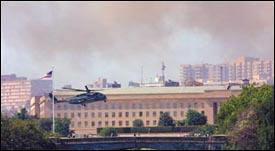
“Averting their eyes from her anguish and trying, wishing, not to hear her cries, students treaded past her and through the Leavey Center foyer. At 10:30 a.m. some went in and others went out, caught in a swell of chaos so absolute that it did not seem like chaos at all. She just stood there, her blond hair flapping with every painful shudder, her fright hand stabbing the air with a metallic cell phone. Her anger, for now, she directed at the phone. ‘I can’t get them. I can’t talk to them,’ she cried.”
So began The Hoya’s coverage of the terror attacks that shook the nation on Sept. 11, 2001.
The Sept. 11 attacks were personal for the Georgetown community, claiming the lives of several alumni. Clouds of smoke billowing from the Pentagon were visible from the Village A rooftops.
Fourteen years have passed since that incomprehensible September morning, and our understanding of the attacks and their aftermath has grown in the past decade and a half. Revisiting The Hoya’s coverage of the attacks gives us the unique opportunity to reflect on the Georgetown community’s immediate reaction to the tragedy.
A Call for Interfaith Understanding
Representatives of the Muslim Student Association penned a viewpoint (“In Time of Crisis, Americans Must Act With Tolerance,” A4, Sept. 14, 2001) expressing grief over the terror attacks and urging tolerance in the wake of the tragedy.
“While we share our fellow Americans’ sentiments of grief, loss and despair, we also find ourselves at a difficult crossroads. Like every other American, we are filled with the same fear and vulnerability that this attack has forced upon our nation. Yet we are also faced with false associations of our religion with the perpetrators alleged to have committed these acts,” the representatives wrote.
The piece referenced a number of crimes targeting Muslim Americans in the days following the attacks, including the vandalization of mosques and Muslim-owned businesses, and verbal abuse and threats aimed at Muslim women wearing veils.
Campus Ministry hosted silent candlelight vigil in Copley Crypt for students of all faiths on Sept. 12. Students also gathered that evening at a Muslim prayer service in Copley Formal Lounge and a Catholic mass in Dahlgren Chapel.
A number of religious services brought students and community members of different faiths together in the days after the terror attacks. Then-D.C. mayor Anthony Williams (D) and then-Roman Catholic Cardinal of Washington Theodore Cardinal McCarrick led an interfaith prayer service in Gaston Hall on Sept. 13. The service included speakers from the Baha’i, Hindu-Jain, Islamic, Jewish, Latter-day Saints, Protestant, Roman Catholic and Sikh traditions.
Remembering Our Fallen
The Hoya’s pages were filled with articles about unity, uncertainty and grief in the weeks following the 9/11 attacks, but some stories stood out in their poignancy. Until mid-October 2001, the front page of nearly every issue of The Hoya, published twice-weekly, reported members of the Georgetown community missing or dead.
Georgetown Public Policy Professor Leslie Whittington, 45, was a passenger on American Airlines Flight 77, and was killed when the hijacked plane crashed into the Pentagon after departing from Dulles International Airport. Whittington was en route to Australia, where she planned to spend two months working as a fellow at Australian National University in Canberra. Her husband, Charles Falkenberg, 45, and their two daughters Zoe, 8, and Dana, 3, accompanied her.
Alumna Lisa J. Raines (LAW ’82) was also among the 64 people who died on American Airlines Flight 77. Raines was the first confirmed Georgetown graduate to have been killed in the terror attacks.
In the days and weeks following the attacks, more and more Hoyas were confirmed dead. Thomas Galvin (GSB ’90), Joe Eacobacci (COL ’96), Sara Manley (COL ’92), Jason Sabbag (COL ’97), Patrick Sullivan (GSB ’91), Stephen Cangialosi (CAS ’83), Matthew Leonard (CAS ’84) and Daniel McNeal (GRD ’00) all lost their lives in the World Trade Center.
Georgetown’s Responsibility to Act
Throughout the grief, uncertainty and confusion following the attacks, a message of resilience persisted.
“Georgetown has a special role to play in the world beyond our campus gates. We contribute to the body of knowledge and public discourse as the nation seeks understanding and healing,” University President John J. DeGioia wrote in a viewpoint (“Georgetown Has a Unique Mission in Crisis,” A3, Sept. 14, 2001). “Through this reasoned dialogue and the wisdom of knowing one another and ourselves we can take our first steps in the process of rebuilding.”
The Georgetown University Alumni and Student Federal Credit Union pledged to match students’ donations to the American Red Cross Disaster Relief Fund and donated a total of $15,491 in October 2001. Over 260 students participated in a blood drive in Bulldog Alley.
Former President Bill Clinton (SFS ’68) and former Senate Majority Leader Bob Dole announced a scholarship fund for the children and spouses of victims of the Sept. 11 attacks in a Healy Hall speech on Sept. 30, 2001.
Many students participated in preemptive anti-war demonstrations on campus and in D.C., while others said that they would support the use of U.S. military force against those responsible for the attacks.
Classes ended at 11:50 a.m. on Friday, Sept. 14, 2001, and the university devoted the rest of the day to reflection and remembrance.
The Hoya’s Editorial Board called on students to be thoughtful and tolerant as they braved this new state of the world in a Sept. 14 editorial (“A Generation Changed?” A2, Sept. 14, 2001).
“We will be called upon in different ways than were our parents and grandparents, in ways that remain to be defined,” the Editorial Board wrote. “Oftentimes it will not be our government issuing the call. It will be ourselves, calling to each other to raise the standard of tolerance and thoughtfulness. … We also should give our lives, not through death, but through a life lived with vigorous, humane attention to the disagreements of our community and our world.”
Photo: File Photo: Charles Nailen/The Hoya







